O
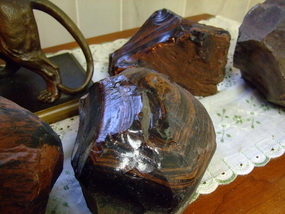
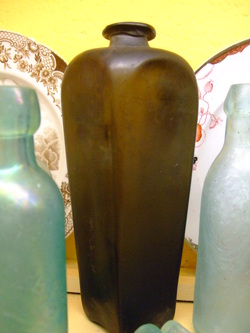
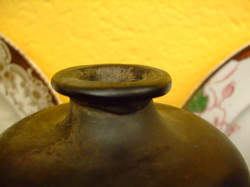
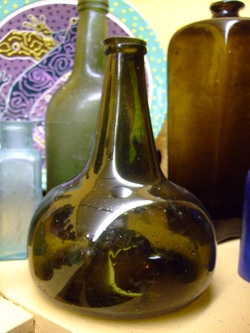
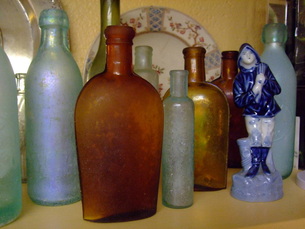
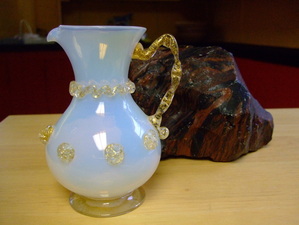
|
The mailman staggered up to the door the other day with a box that weighed over 31 pounds, for which I apologized. It wasn't a piece of railroad iron, useful as that would be. It was four cantaloupe-sized boulders of Oregon obsidian, nicely veined with red streaks. What excuse is there--I collect glass. O  Obsidian is glass. It is effectively the same thing as the bottle-collectors' "black glass," which looks blackish but is more or less dark green. Held up to the light, black bottle glass shows a range of green shades from smoky olive up to a fairly clear deep green. The coloration results from impurities in the sand the bottles were made from. Different impurities resulted in amber or dark brown glass. Obsidian sliced to the same thickness displays the same translucent impure gray, green, or amber lights. And like old bottle glass, obsidian also comes in purity grades with some clearer or greener and some more opaque. Glass collectors might do well to keep some obsidian around to remind them where glass got its start. It's fun stuff.  The idea of purifying glass to control clarity and color dates back to Pharaonic Egypt but bottle manufacturers making utility glass for the most part didn't worry about that until historically recent times. The old black utility glass thus seems like a natural product, fused and metalled and then blown on a pipe, either free-blown or blown into a mold, to produce characteristic shapes and then have a neck stuck on. Here is a pig-snout gin bottle blown into a partial mold to produce the gin shape.  The hand-tooled snout on the gin bottle was fused on while the glass was still hot.  Here is a horse-hoof wine bottle blown and shaped with a tool, with a string neck. Both bottles could have originally contained wine or sherry or rum or other whiskey or porter. In the mid-18th-century, the bottle-blowers didn't care if the glass came out natural-colored and the spirit merchants didn't care what they put into it. Bottles were also reused. Over time however, the tapered square quickly came to be associated with Holland and gin, and the onion-shaped or hoof-shaped bottles came to be associated with Hogarth prints, pirates, and rum.  Just as we would like our obsidian to be blown out of volcanoes, we would ideally like our old bottles to come out of the sea. Latrines and old filled-in wells are probably the next best, followed by attics and basements, but really nothing beats the seas and estuaries for washing up an interesting bottle. Here is a nice sand-blasted amber colored strap-shouldered whiskey flask from the Atlantic. The short aqua colored bottle next to it is a patent medicine bottle from Pamlico Sound. The other bottles on this shelf are blob top sodas from the Chesapeake, all circa 1880s, and two more whiskey flasks. The subtle opalescent and iridescent colors on this glass are the result of salt and muck interacting with the glass, producing the colors that originally inspired Tiffany, Loetz, Kralik and other art glass makers. Aqua glass was the intermediate stage before modern commercial color-controlled glass. In the mid-19th century, purer glass was sought, but not at the cost of producing entirely clear glass for bottles. The result was an aqua blue or aqua green glass, clearer, with fewer impurities, no longer black glass, and for the most part no longer reused. Though mold-blown, the blob tops on these bottles were still done by hand with blobs of glass.  In today’s world, commercial utility glass production continues on a vast scale. It's non-carcinogenic and has considerable reuse potential as a hard and brittle mineral substance. It can also be used to make objects of remarkable delicacy and beauty, like this Murano glass pitcher from the 1960s. Still, it's hard to beat volcanoes for those of us who would like to see glass flowing in molten rivers.
1 Comment
Chrissy Bell
1/8/2014 06:10:06 am
Loved your post! I always feel like I learn so much from almost anything you write. Not sure I ever knew that about obsidian! Now, next time I visit, I must look more carefully at your glass collection! Stay warm please!
Reply
Leave a Reply. |
AuthorGary Dale Mawyer, a Central Virginia native, has over 40 years of publishing and editing experience and lives with his wife Karen and two cats in Albemarle County. Sites I likeafroculinaria.com/
largea.wordpress.com/livinglisteningandthingsilove naturalpresencearts.com/ someperfectfuture.com Archives
July 2024
|